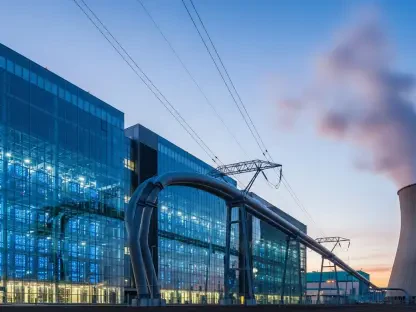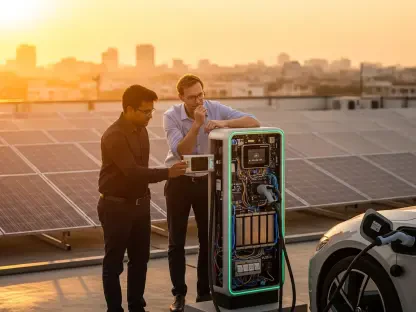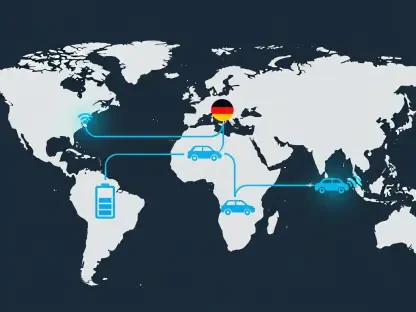The energy sector finds itself at a pivotal moment, grappling with transformative forces such as the political landscape shaped by President Donald Trump, the meteoric rise of artificial intelligence (AI), and the accelerating drive toward global electrification. At a recent summit in Houston, hosted by BloombergNEF, industry leaders, executives, and investors convened to dissect these complex dynamics. Their discussions unveiled a terrain marked by both significant obstacles and promising prospects as businesses adapt to policy unpredictability and technological upheaval. With Trump’s selective stance on clean-tech incentives casting uncertainty, alongside the immense infrastructure demands fueled by AI, the event offered a stark glimpse into an industry navigating uncharted waters. This exploration delves into the critical themes that surfaced, shedding light on the evolving path of the energy transition and the innovative strategies emerging in response to these formidable challenges.
Policy and Regulation: A Make-or-Break Factor
Navigating Domestic Uncertainty and Global Opportunities
The critical role of regulatory frameworks in scaling green technologies emerged as a central focus during the Houston summit. Industry experts emphasized that shifting carbon markets from voluntary participation to structured, globally regulated systems is vital for driving down costs and securing sustained demand for solutions like carbon dioxide removal credits. The concept of the “Valley of Death”—the perilous gap between innovation and commercial success—was frequently cited as a barrier that only robust policy can bridge. Without a blend of incentives and enforceable mandates, many promising technologies risk languishing in development limbo. The consensus pointed to government intervention as not just beneficial but indispensable, especially in an environment where domestic policy fluctuations under the Trump administration have heightened uncertainty for clean energy initiatives.
A notable trend accompanying this regulatory discourse is the strategic pivot of U.S. companies toward international markets. With domestic support for clean tech wavering, firms in sectors like green hydrogen and carbon capture and storage (CCS) are increasingly eyeing regions with stronger policy backing, such as Europe. For instance, exporting green hydrogen to markets with established incentives is gaining traction as a feasible alternative. Similarly, carbon removal products are being aligned with mandated markets like the European Union, where emissions trading schemes offer clearer financial returns. This global reorientation reflects a pragmatic response to uncertainty at home, highlighting how regulatory disparities across borders are reshaping investment strategies and market priorities in the clean energy space.
Balancing Incentives and Mandates for Progress
Another dimension of the regulatory challenge lies in crafting a balanced approach that combines incentives with strict mandates to propel green technologies forward. Summit participants argued that subsidies act as a crucial catalyst, making alternative fuels competitive against traditional crude oil. However, without accompanying mandates to enforce adoption, the impact of financial support remains limited. This dual mechanism—often described as “carrots and sticks”—is seen as essential to ensure that innovations achieve market penetration. The absence of such frameworks risks stalling progress, particularly for technologies that require long-term investment and guaranteed demand to become viable. The urgency of establishing these policies is amplified by the rapid pace of technological change and the pressing need to meet global sustainability targets.
The implications of regulatory inconsistency were also a point of concern, as uneven policies create a patchwork of challenges for companies operating across multiple regions. For industries like CCS, where upfront costs are significant, the lack of cohesive global standards can deter investment and slow deployment. Panelists at the summit underscored the need for harmonized regulations that provide clarity and predictability, enabling firms to plan effectively. This is particularly relevant in the context of domestic policy shifts under the current administration, which have prompted calls for international collaboration to create a more stable foundation for clean energy growth. The dialogue revealed a shared recognition that policy coherence is not just a domestic issue but a global imperative for the energy transition.
Infrastructure Demands: The Grid Under Pressure
Meeting the Surge from AI and Electrification
The U.S. power grid is confronting an extraordinary test: the need to double its capacity within the next 15 years to accommodate soaring demand from AI data centers and electrification initiatives like electric vehicles (EVs). Industry leaders at the summit highlighted the staggering scale of this challenge, noting that a system built over more than a century must now expand at an unprecedented rate. Proposals for national policies to develop high-voltage transmission lines were put forward as a cost-effective way to connect the country’s major grids. Additionally, innovative hardware solutions were touted for their potential to drastically reduce the time required to link data centers to power sources. The urgency of these measures cannot be overstated, as delays in grid expansion could hinder technological and economic progress across multiple sectors.
Compounding this infrastructure challenge is the sheer complexity of integrating new demands into an aging system. AI data centers, with their intensive energy needs, represent a new frontier of consumption that the current grid is ill-equipped to handle. Simultaneously, the push for electrification—spanning everything from personal EVs to industrial applications—adds another layer of strain. Experts at the event stressed that without swift action, bottlenecks could derail critical advancements. The call for streamlined permitting processes and federal coordination to accelerate grid projects resonated strongly, as did the recognition that technological innovation must work hand-in-hand with policy reform. This dual approach is seen as the linchpin for ensuring the grid can keep pace with the rapid evolution of energy needs.
Financial and Social Implications of Expansion
The financial ramifications of this massive grid expansion sparked heated discussion, with a key question lingering: who will bear the cost of this transformation? AI data centers, while indispensable for business operations and national security, generate far fewer long-term jobs compared to historical infrastructure endeavors, raising concerns about economic fairness. Industry voices pointed out that the burden of funding could disproportionately fall on consumers if equitable cost-sharing mechanisms are not established. This financial tension is further complicated by the need for rapid, affordable power generation to support expanding EV fleets, particularly for heavy-duty trucks where electric costs per mile must compete with diesel. The stakes are high, as missteps in funding allocation could undermine public support for the energy transition.
On the social front, the implications of infrastructure growth reveal a nuanced balance between progress and equity. Unlike past projects that created widespread employment opportunities, the build-out of data centers offers limited job creation, prompting debates over the societal value of such investments. Meanwhile, the parallel demand for EV infrastructure introduces additional layers of complexity, as communities and businesses grapple with the costs and benefits of electrification. Technological solutions, such as battery storage to stabilize fluctuating power demands, were highlighted as potential mitigators of these challenges. Yet, the broader social outcomes remain uncertain, underscoring the need for policies that prioritize inclusivity alongside innovation. The summit discussions made it clear that addressing these social dimensions is as critical as solving technical hurdles.
Intersecting Sectors: Energy, Agriculture, and Beyond
Biofuels as a Lifeline for Farmers
An intriguing intersection between energy policy and agriculture emerged as a key topic at the summit, with biofuels positioned as a potential lifeline for U.S. farmers facing low commodity prices and ongoing trade disputes. Recent proposals around biofuel blending mandates suggest a possible alignment with supportive measures from the Trump administration, providing much-needed visibility and financial incentives for agricultural communities. This development is significant, as it not only offers economic relief to farmers but also aligns with broader sustainability goals by promoting cleaner fuel alternatives. The dual impact of biofuels illustrates how energy policies can ripple across seemingly disparate sectors, forging unexpected synergies that benefit both the environment and rural economies in a time of uncertainty.
Delving deeper into this intersection, the role of biofuels extends beyond immediate economic support to a strategic alignment with national energy objectives. By integrating agricultural byproducts into the energy supply chain, biofuels help reduce reliance on fossil fuels while bolstering domestic production. Industry representatives at the event emphasized that clear, consistent mandates are essential to ensure farmers can plan and invest with confidence. This policy clarity is particularly crucial amidst fluctuating trade policies that have disrupted agricultural markets. The potential for biofuels to serve as a stabilizing force for both energy and agriculture underscores the interconnected nature of modern policy challenges, highlighting the need for integrated approaches that address multiple societal needs simultaneously.
Energy Policy’s Broader Societal Impact
The ripple effects of energy policy on other sectors were further explored, revealing a complex web of interdependencies that shape broader societal outcomes. Beyond agriculture, the implications of energy decisions touch areas like national security, economic stability, and environmental health. For instance, the rapid build-out of AI infrastructure, while driven by energy demands, also plays a critical role in maintaining technological competitiveness on a global scale. Summit discussions pointed to the need for holistic policymaking that considers these interconnected impacts, ensuring that energy transition strategies do not inadvertently exacerbate inequalities or overlook critical dependencies. This broader perspective is vital for crafting solutions that are both sustainable and equitable across diverse communities.
Another facet of this societal impact lies in the potential for energy innovations to drive systemic change across industries. The integration of technologies like battery storage and grid enhancements not only addresses immediate energy needs but also sets the stage for long-term resilience in sectors ranging from transportation to manufacturing. Experts at the summit advocated for cross-sector collaboration to maximize these benefits, suggesting that partnerships between energy firms, agricultural stakeholders, and technology providers could unlock new pathways for progress. This collaborative ethos reflects a growing recognition that the energy transition is not an isolated endeavor but a shared journey with far-reaching implications. The challenge lies in aligning these diverse interests to create a cohesive vision for the future.
Reflecting on Pathways Forward
Looking back on the insights shared at the Houston summit, the intricate challenges of the energy transition came into sharp focus, shaped by political shifts under Trump’s administration and the relentless advance of AI technologies. The event illuminated a sector wrestling with domestic policy uncertainties, immense infrastructure pressures, and the financial and social intricacies of rapid change. Yet, amidst these hurdles, actionable strategies emerged—pivoting to global markets for clean energy opportunities, leveraging technological innovations like battery storage, and advocating for robust regulatory frameworks proved to be recurring themes of resilience. Moving forward, the emphasis must shift to fostering international collaboration, securing equitable funding models for grid expansion, and integrating cross-sector solutions like biofuels to address both economic and environmental goals. These steps offer a roadmap for navigating the evolving energy landscape, ensuring that adaptability and innovation remain at the forefront of building a sustainable future.









